Gennaro Cuofano's Blog, page 140
November 26, 2021
What Is Design Strategy? Design Strategy In A Nutshell
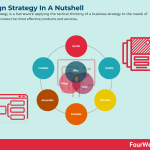
Design strategy is a framework applying the tactical thinking of a business strategy to the needs of the user to create the most effective products and services.
Understanding design strategyDesign strategy involves the creation of a guiding set of principles that articulate the company mission and vision with the design of its products and services.
Put differently, design strategy is a way of translating the intent of a business, product, or service into the experience of that business, product, or service. To that end, the strategy occupies the crucial middle ground between what the business wants and what the people need. It’s important to note that both business goals and user needs must also be aligned with existing technical constraints to develop competitive products.
This means a design strategy must detail:
What success means (and for whom) and how success will be measured. How can both the business and the company win?The problem the company is addressing and why it needs to be solved. How is the company making customer lives easier?The unique value proposition (UVP). What is the company’s competitive advantage?A set of design principles, which we touched on earlier.Why does design strategy matter?On the surface, it may appear design strategy has very little to do with actual design. However, there are tangible links between design strategy and successful design.
How exactly does design strategy add value to a business? Consultancy firm McKinsey and Company decided to find out. After conducting comprehensive and rigorous studies on the subject, they found that:
The companies with the best design strategies increased their revenue at nearly twice the rate of industry competitors. The same can also be said for shareholder returns.There was a strong correlation between high design scores and superior business performance. Businesses were better able to achieve short and long-term goals.The notion of superior design leading to superior business performance is consistent across different industries.The user/customer marketplace disproportionately rewards brands with good design habits. These habits use familiar language to increase trust, brand recall, brand recognition, user satisfaction, and the customer experience.The three core benefits of design strategyAs an addendum to the McKinsey and Company study, let’s now take a look at benefits that help business operations more generally.
Cost-effectivenessDesign strategy enables the organization to clearly define who its target audience is, what they need, and how it can create value for them. Products based on these insights tend to be more successful when released to the market and can easily be improved with subsequent iterations.
Ultimately, the right product is a cost-effective product backed by robust research. Due diligence during the development stage helps the organization avoid a scenario where it has to spend time and money attempting to rescue a failed product. However, as Peter Thiel intimated in his book Zero to One, no amount of iteration will remedy a product that should not have been built in the first place.
DirectionOrganizations that have clear and understandable goals tend to perform better because employees are empowered and engaged to achieve them.
A good design strategy removes the trivial decision-making that can sometimes plague product development. This means the design team has more time to focus on meaningful issues that matter to the customer or increase productivity.
PrioritizationMany businesses proclaim they are user-oriented, but a design team with too much of a user focus can end up developing features that are costly, time-intensive, and only result in modest gains.
In theory, design strategy helps a user-oriented organization focus on product features that strike the best balance between low effort and high reward. This helps the team create the most value for the largest cohort of their target audience and is a far more sustainable approach than the alternative.
Key takeaways:Design strategy is a framework applying the tactical thinking of business strategy to the needs of the user to create the most effective products and services. The strategy occupies the crucial middle ground between what the business wants and what the people need.Design strategies should detail what success looks like for the business and the customer. They should also detail what the problem is and why it needs to be solved. Lastly, it should detail the unique value proposition that gives the business a competitive advantage.Design strategy has many benefits for organizations. In a study conducted by McKinsey and Company, design strategy was linked with increased revenue, superior business performance, and increased consumer trust. More generally speaking, design strategy facilitates cost-effective product development, smarter resource allocation, and feature prioritization.Related concepts to design strategy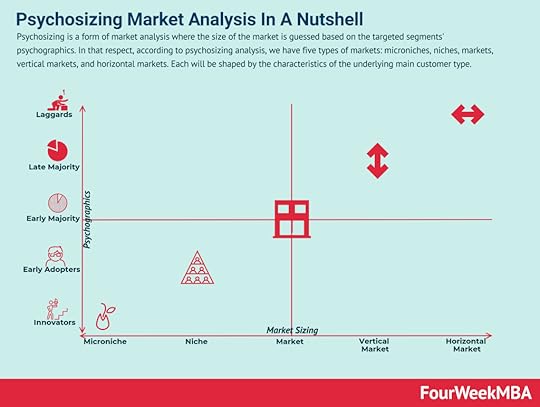 Psychosizing is a form of market analysis where the size of the market is guessed based on the targeted segments’ psychographics. In that respect, according to psychosizing analysis, we have five types of markets: microniches, niches, markets, vertical markets, and horizontal markets. Each will be shaped by the characteristics of the underlying main customer type.
Psychosizing is a form of market analysis where the size of the market is guessed based on the targeted segments’ psychographics. In that respect, according to psychosizing analysis, we have five types of markets: microniches, niches, markets, vertical markets, and horizontal markets. Each will be shaped by the characteristics of the underlying main customer type.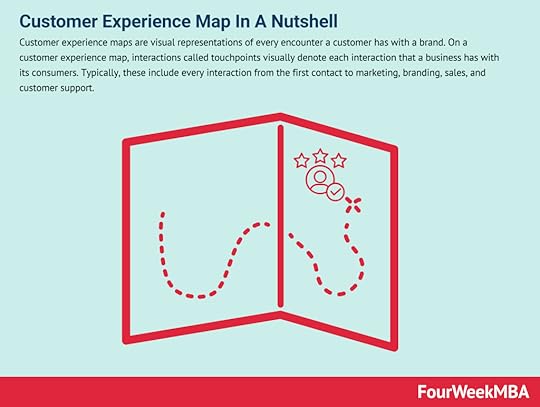 Customer experience maps are visual representations of every encounter a customer has with a brand. On a customer experience map, interactions called touchpoints visually denote each interaction that a business has with its consumers. Typically, these include every interaction from the first contact to marketing, branding, sales, and customer support.
Customer experience maps are visual representations of every encounter a customer has with a brand. On a customer experience map, interactions called touchpoints visually denote each interaction that a business has with its consumers. Typically, these include every interaction from the first contact to marketing, branding, sales, and customer support.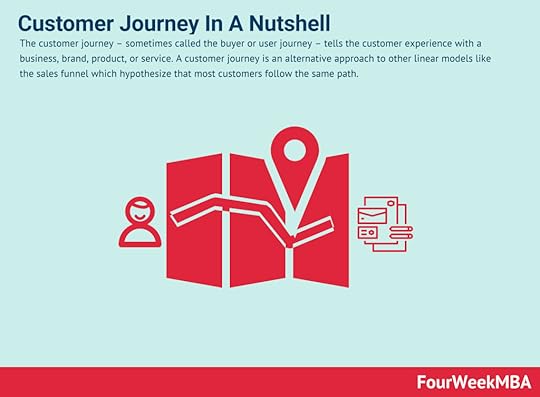 The customer journey – sometimes called the buyer or user journey – tells the customer experience with a business, brand, product, or service. A customer journey is an alternative approach to other linear models like the sales funnel which hypothesize that most customers follow the same path.
The customer journey – sometimes called the buyer or user journey – tells the customer experience with a business, brand, product, or service. A customer journey is an alternative approach to other linear models like the sales funnel which hypothesize that most customers follow the same path.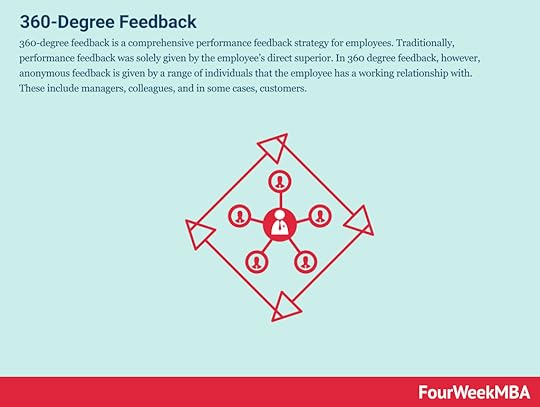 360-degree feedback is a comprehensive performance feedback strategy for employees. Traditionally, performance feedback was solely given by the employee’s direct superior. In 360 degree feedback, however, anonymous feedback is given by a range of individuals that the employee has a working relationship with. These include managers, colleagues, and in some cases, customers.
360-degree feedback is a comprehensive performance feedback strategy for employees. Traditionally, performance feedback was solely given by the employee’s direct superior. In 360 degree feedback, however, anonymous feedback is given by a range of individuals that the employee has a working relationship with. These include managers, colleagues, and in some cases, customers.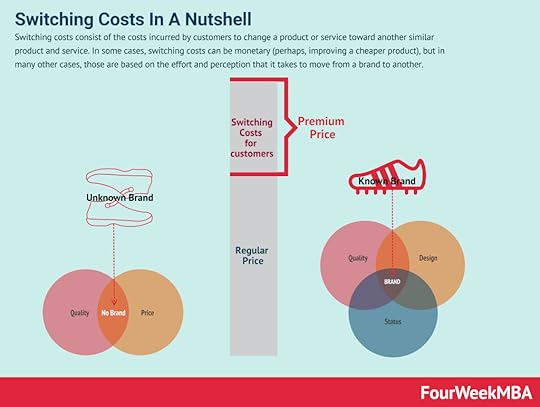 Switching costs consist of the costs incurred by customers to change a product or service toward another similar product and service. In some cases, switching costs can be monetary (perhaps, improving a cheaper product), but in many other cases, those are based on the effort and perception that it takes to move from a brand to another.
Switching costs consist of the costs incurred by customers to change a product or service toward another similar product and service. In some cases, switching costs can be monetary (perhaps, improving a cheaper product), but in many other cases, those are based on the effort and perception that it takes to move from a brand to another.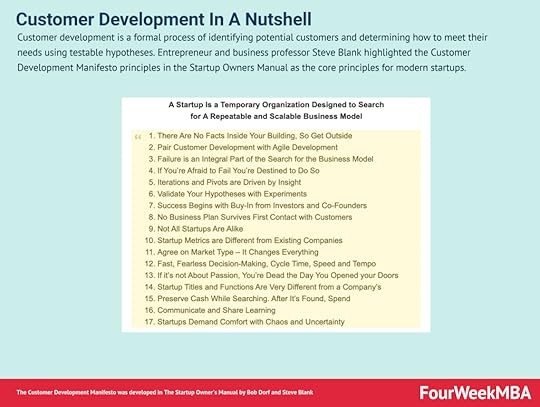 Customer development is a formal process of identifying potential customers and determining how to meet their needs using testable hypotheses. Entrepreneur and business professor Steve Blank highlighted the Customer Development Manifesto principles in The Startup Owner’s Manual as the core principles for modern startups.
Customer development is a formal process of identifying potential customers and determining how to meet their needs using testable hypotheses. Entrepreneur and business professor Steve Blank highlighted the Customer Development Manifesto principles in The Startup Owner’s Manual as the core principles for modern startups.Main Free Guides:
Business ModelsBusiness StrategyBusiness DevelopmentDigital Business ModelsDistribution ChannelsMarketing StrategyPlatform Business ModelsRevenue ModelsTech Business ModelsBlockchain Business Models FrameworkThe post What Is Design Strategy? Design Strategy In A Nutshell appeared first on FourWeekMBA.
November 17, 2021
Digitally-Enhanced Business Models
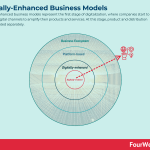
Digitally-enhanced business models represent the first stage of digitalization, where companies start to leverage digital channels to amplify their products and services. At this stage, product and distribution are still treated separately.
Introduction to digitally-enhanced business modelsWhen it comes to digitally enhanced business models, those are the starting point of the so-called “digital transformation journey.” Beyond buzzwords or complex terms, what it really means is a company starts to use digital channels to amplify its products and services.
Think of the case of a company that starts to understand the logic of search engines, social media, and in general what it means to communicate online. In this first level of digitalization, the nature of the product or service is not changed, only the perception and how the product is communicated changes. In this phase, the company starts to realize the potential of the web.
And it starts to gain its first customers through digital marketing and digital channels. However, it treats the web only as a distribution channel, rather than the primary value enhancement platform to change the way the product and service is designed, developed, built and delivered.
Thus, this really represents that first step toward digitalization. The value proposition itself isn’t changed, but the perception around it can be enhanced. While this is a great first step, and for many small businesses it does work in the long term. It works to a certain extent.
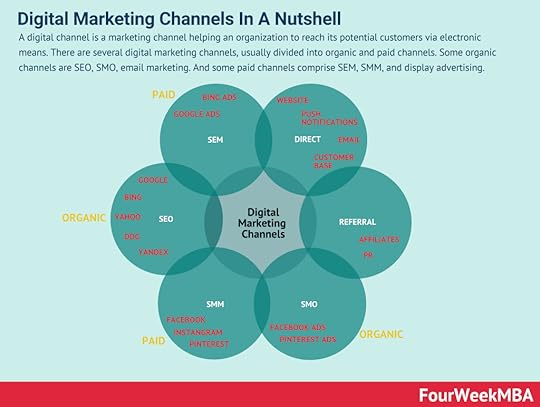 A digital channel is a marketing channel, part of a distribution strategy, helping an organization to reach its potential customers via electronic means. There are several digital marketing channels, usually divided into organic and paid channels. Some organic channels are SEO, SMO, email marketing. And some paid channels comprise SEM, SMM, and display advertising.
A digital channel is a marketing channel, part of a distribution strategy, helping an organization to reach its potential customers via electronic means. There are several digital marketing channels, usually divided into organic and paid channels. Some organic channels are SEO, SMO, email marketing. And some paid channels comprise SEM, SMM, and display advertising.At this stage, the company starts to understand the realm of possibilities that the web offers. It starts to explore the various digital marketing channels. And while doing so it experiments with many of them, while tuning in those that might fit well with the core product and service.
Over time, the company might specialize in a core channel, while still leveraging on a multi-channel strategy. Thus, here, the company starts to realize that in order to take full advantage of digitalization it needs to integrate those channels as part of the product and service development.
Therefore, the digital channel isn’t just used to amplify the product or service. It starts to pervade various stages of the business. From product discovery (by leveraging on data offered by the various channels to identify demand) to product development (by gathering customers’ feedback early on) to quick iteration and experimentation (by testing what works and what doesn’t) and by realizing that the next step of this process is breaking down the walls between product and distribution.
Read Next: Stages of Digital Transformation.
Main Free Guides:
Business ModelsBusiness StrategyBusiness DevelopmentDigital Business ModelsDistribution ChannelsMarketing StrategyPlatform Business ModelsRevenue ModelsTech Business ModelsBlockchain Business Models FrameworkThe post Digitally-Enhanced Business Models appeared first on FourWeekMBA.
The Four Stages Of Digital Transformation
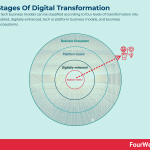
Digital and tech business models can be classified according to four levels of transformation into digitally-enabled, digitally-enhanced, tech or platform business models, and business platforms/ecosystems.
Toward digital transformationThere are numerous ways to classify tech business models, for the sake of the analysis done on FourWeekMBA, we’ll classify them according to the level to which tech effectively changes/enhances the value proposition for users/customers. Indeed, we initially defined a tech business model, as a business where technology plays a key role, not for its own sake, but for the sake of enhancing the value proposition for the individual user/customer and enabling that value proposition to scale. Therefore, individual enhanced value propositions (the single user/customer is better off) and enhanced collective value propositions (the more users join in the more the service/product becomes valuable – aka Network Effects) become commandments of a viable tech business model.
For the sake of it, let’s see four key types of models:
Level one: tech and digitally-enabledDigital embracing primarily how the product is framed and communicated to the customer/user.
In this specific case, technology plays a key role in communicating/distributing the product, but little in shaping it. Thus, take the example of a company that has simply built a website and communicates its product via that (communication level).
Or a company that has learned how to integrate digital marketing within its own corporate strategy. In that case, this is the most basic way to apply technology to a business model. There is no change in how the value proposition is shaped but rather to how it is communicated or distributed.
Here technology is used to better communicate the product/service.
 A digital channel is a marketing channel, part of a distribution strategy, helping an organization to reach its potential customers via electronic means. There are several digital marketing channels, usually divided into organic and paid channels. Some organic channels are SEO, SMO, email marketing. And some paid channels comprise SEM, SMM, and display advertising.Level two: tech-enhanced
A digital channel is a marketing channel, part of a distribution strategy, helping an organization to reach its potential customers via electronic means. There are several digital marketing channels, usually divided into organic and paid channels. Some organic channels are SEO, SMO, email marketing. And some paid channels comprise SEM, SMM, and display advertising.Level two: tech-enhanced Digital enhances the value proposition, therefore it hits at the core of the company’s business model (Hint: Product And Distribution merge)
In that case, technology does impact the way the product is built and delivered. Take the case of a company that built its e-commerce and distributed its products via that, while at the same time it has learned how to integrate customers’ feedback quickly from the online platform to the way the product is designed.
In that case, technology is helping shape the product/service, thus making it more valuable to potential customers.
 A tech business model is made of four main components: value model (value propositions, mission, vision), technological model (R&D management), distribution model (sales and marketing organizational structure), and financial model (revenue modeling, cost structure, profitability and cash generation/management). Those elements coming together can serve as the basis to build a solid tech business model.Level three: platforms and interactions
A tech business model is made of four main components: value model (value propositions, mission, vision), technological model (R&D management), distribution model (sales and marketing organizational structure), and financial model (revenue modeling, cost structure, profitability and cash generation/management). Those elements coming together can serve as the basis to build a solid tech business model.Level three: platforms and interactionsFrom transactions to interactions, ecosystems, and flywheels
 A platform business model generates value by enabling interactions between people, groups, and users by leveraging network effects. Platform business models usually comprise two sides: supply and demand. Kicking off the interactions between those two sides is one of the crucial elements for a platform business model success.
A platform business model generates value by enabling interactions between people, groups, and users by leveraging network effects. Platform business models usually comprise two sides: supply and demand. Kicking off the interactions between those two sides is one of the crucial elements for a platform business model success.In this specific case, a company has moved to a different level. Rather than just selling its own products/services it has moved to build the platform (both tech and business) that drives the interaction between two (two-sided platform/marketplace/peer-to-peer) or more parties (multi-sided platform/marketplace).
Think of the classic example of how Amazon moved from selling products on its e-commerce platform to becoming a hosting platform for other e-commerce to build its own stores.
 Amazon Marketplace is the world’s biggest online retailer, with sales greater than the eCommerce sales of entire countries. Marketplace Pulse estimates that there are over five million sellers on the Amazon marketplace, with over two million on Amazon.com alone. Amazon had enviable sales of over $232.8 bn in 2018 just from its product sales, with over 50% of sales coming from third-party vendors.
Amazon Marketplace is the world’s biggest online retailer, with sales greater than the eCommerce sales of entire countries. Marketplace Pulse estimates that there are over five million sellers on the Amazon marketplace, with over two million on Amazon.com alone. Amazon had enviable sales of over $232.8 bn in 2018 just from its product sales, with over 50% of sales coming from third-party vendors.Here technology becomes an enhancer of the interactions between parties, distribution, and continuous flow of information. Platform business models are moved by network effects.
 A network effect is a phenomenon in which as more people or users join a platform, the more the value of the service offered by the platform improves for those joining afterward.
A network effect is a phenomenon in which as more people or users join a platform, the more the value of the service offered by the platform improves for those joining afterward.While network effects, help platforms pick up speed and momentum and create a long-term advantage, also negative network effects are to be taken into account.
 In a negative network effect as the network grows in usage or scale, the value of the platform might shrink. In platform business models network effects help the platform become more valuable for the next user joining. In negative network effects (congestion or pollution) reduce the value of the platform for the next user joining. Level four: business ecosystem
In a negative network effect as the network grows in usage or scale, the value of the platform might shrink. In platform business models network effects help the platform become more valuable for the next user joining. In negative network effects (congestion or pollution) reduce the value of the platform for the next user joining. Level four: business ecosystemTechnology is at the center of the value enhancement model. Yet in order for it to succeed a community of developers, entrepreneurs, and doers need to adopt the business platform.

This level combined technology and distribution. Where a company has moved to a point where it focuses on governance design, and the underlying tech platform is built and shaped according to that. A classic example is the App Store, and how this has become a business ecosystem, with multiple stakeholders where governance design has become a key component.
Another example that is emerging strongly as a result of the Blockchain, with protocols like Ethereum that enable smart contracts or a whole set of potential applications.
 A Blockchain Business Model is made of four main components: Value Model (Core Philosophy, Core Value and Value Propositions for the key stakeholders), Blockchain Model (Protocol Rules, Network Shape and Applications Layer/Ecosystem), Distribution Model (the key channels amplifying the protocol and its communities), and the Economic Model (the dynamics through which protocol players make money). Those elements coming together can serve as the basis to build and analyze a solid Blockchain Business Model.
A Blockchain Business Model is made of four main components: Value Model (Core Philosophy, Core Value and Value Propositions for the key stakeholders), Blockchain Model (Protocol Rules, Network Shape and Applications Layer/Ecosystem), Distribution Model (the key channels amplifying the protocol and its communities), and the Economic Model (the dynamics through which protocol players make money). Those elements coming together can serve as the basis to build and analyze a solid Blockchain Business Model.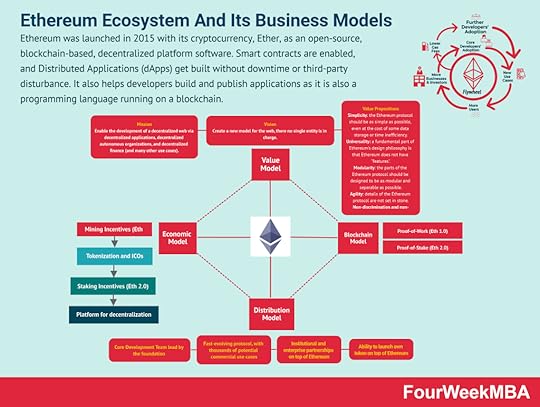 Ethereum was launched in 2015 with its cryptocurrency, Ether, as an open-source, blockchain-based, decentralized platform software. Smart contracts are enabled, and Distributed Applications (dApps) get built without downtime or third-party disturbance. It also helps developers build and publish applications as it is also a programming language running on a blockchain.
Ethereum was launched in 2015 with its cryptocurrency, Ether, as an open-source, blockchain-based, decentralized platform software. Smart contracts are enabled, and Distributed Applications (dApps) get built without downtime or third-party disturbance. It also helps developers build and publish applications as it is also a programming language running on a blockchain.In this case, technology becomes an enhancer of governance design, policies, and stakeholder value.
Read Next: Digital Business Models, Tech Business Models, Blockchain Business Models.
Main Free Guides:
Business ModelsBusiness StrategyBusiness DevelopmentDigital Business ModelsDistribution ChannelsMarketing StrategyPlatform Business ModelsRevenue ModelsTech Business ModelsBlockchain Business Models FrameworkThe post The Four Stages Of Digital Transformation appeared first on FourWeekMBA.
Constructive Paranoia: How To Leverage Constructive Paranoia To Avoid Ruin In Business
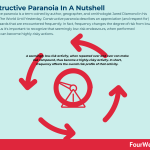
Constructive paranoia is a term coined by author, geographer, and ornithologist Jared Diamond in his 2012 book The World Until Yesterday. Constructive paranoia describes an appreciation (and respect for) low-risk hazards that are encountered frequently. In fact, frequency changes the degree of risk from low to high. Thus it’s important to recognize that seemingly low-risk endeavors, when performed frequently, can become highly-risky actions.
Understanding constructive paranoiaIn the book, Diamond describes his experiences studying the tribal people of New Guinea. During one of his trips, he noticed that his native guides refused to sleep under dead trees. He thought this behavior to be irrational at first, but as he spent more time in the forest, he began to hear trees falling daily. His guides also shared stories around the campfire each night of friends and relatives who had been killed by falling trees.
Diamond reckoned tribe members spent around 100 nights a year camping in the forest. Even if the chance of being killed by a falling tree was low, this small risk compounded with every night spent amongst the trees. “If you’re a New Guinean living in the forest, and if you adopt the bad habit of sleeping under dead trees whose odds of falling on you that particular night are only 1 in 1,000, you’ll be dead within a few years”, Diamond noted.
The hypervigilant attitude of the locals toward repeated low-risk activities Diamond called constructive paranoia. With most New Guineans living a long way from adequate healthcare, they considered the risk of death – no smaller how small – in their decision-making.
Constructive paranoia in the modern worldIn the modern world, Diamond argued constructive paranoia was misdirected. Many American citizens exaggerated the risk of an event beyond their control, such as shark attacks, plane crashes, nuclear radiation, and mass shootings.
Conversely, they underestimated the risk of an event under their control which caused them to approach it with a careless attitude. While shark attacks account for one death every two years, statistics show falling out of bed claims more than 450 lives annually. Other relatively trivial and mundane causes of death include accidents involving:
Ladders.Balloons – not the hot-air variety, but the small latex balloons used for celebrating birthdays. Lawnmowers and small tractors.Vending machines.Staircases.Bathtubs – where over three hundred people drown each year. Driving – with approximately 38,000 deaths every year on U.S. roads.What causes misdirected constructive paranoia?In the West, misdirected constructive paranoia is caused by the availability heuristic.
Here, topics or concepts people are exposed to the most are misconstrued as having a higher chance of occurring. The media is at least partly to blame for this mental shortcut.
It’s important to highlight though, that people in general, have natural filters to understand when situations carry intrinsic and hidden risks. For instance, many intellectuals tend to blame people for their misplaced concerns about terrorism, which seems to carry a very low probability of happening.
Yet, even so, terrorism requires continuous paranoia and extreme attention by everyday people. That is why it also occupies a place in our mind which is greater than other more frequent risks. In short, also here, it might be easy to blame people for having misplaced worries. Instead, nonetheless the news broken circuit, people still know how to filter information and where to place their attention to.
On the contrary, when people believe that they could never die from engaging in a mundane activity such as driving a car or using a ladder. This is known as the optimism bias, where the individual mistakenly believes they are less likely to experience misfortune and more likely to experience success.
Constructive paranoia in businessIn business, constructive paranoia is a common trait of many successful, long-term investors.
Warren Buffett believes investing should be approached in the same way as gambling, where investors protect the downside at all costs. In his book The Dhandho Investor, author Mohnish Pabrai essentially calls this strategy “heads I win, tails I don’t lose that much.”
To that end, Buffet is risk-averse, preferring to make investments where the potential downside is low (or none at all) if something goes wrong. In short, in business constructive paranoia makes you think outside the box, to devise solutions where you can create an upside, with very very limited downside. By placing attention on hidden risks carried by everyday business situations, the constrictive paranoid business person can actually identify opportunities where others can’t.
Entrepreneur Richard Branson also used constructive paranoia to his advantage during the early days of Virgin Atlantic. He protected the downside of purchasing a new plane by convincing Boeing to lend him a second-hand 747 for a year.
During a board meeting with directors, Branson argued that in the worst-case scenario, the company would lose six months’ worth of profit and have to give the plane back. Though the tendency is to assume entrepreneurs and investors take all-or-nothing risks, both Buffet and Branson made rational decisions to minimize the potential impact of something going awry.
Key takeaways:Constructive paranoia describes an appreciation (and respect for) low-risk hazards that are encountered frequently. The term was coined by author, geographer, and ornithologist Jared Diamond.In Western society, the impact of events beyond one’s control is exaggerated. Conversely, the impact of events within one’s control is underestimated. This misdirected form of constructive paranoia is caused by the availability heuristic and optimism bias. Constructive paranoia is a trait of successful investors such as Warren Buffett, who seeks to minimize the potential downside of an investment decision. Richard Branson also used constructive paranoia to launch Virgin Atlantic.Related Business Concepts As highlighted by German psychologist Gerd Gigerenzer in the paper “Heuristic Decision Making,” the term heuristic is of Greek origin, meaning “serving to find out or discover.” More precisely, a heuristic is a fast and accurate way to make decisions in the real world, which is driven by uncertainty.
As highlighted by German psychologist Gerd Gigerenzer in the paper “Heuristic Decision Making,” the term heuristic is of Greek origin, meaning “serving to find out or discover.” More precisely, a heuristic is a fast and accurate way to make decisions in the real world, which is driven by uncertainty. The recognition heuristic is a psychological model of judgment and decision making. It is part of a suite of simple and economical heuristics proposed by psychologists Daniel Goldstein and Gerd Gigerenzer. The recognition heuristic argues that inferences are made about an object based on whether it is recognized or not.
The recognition heuristic is a psychological model of judgment and decision making. It is part of a suite of simple and economical heuristics proposed by psychologists Daniel Goldstein and Gerd Gigerenzer. The recognition heuristic argues that inferences are made about an object based on whether it is recognized or not.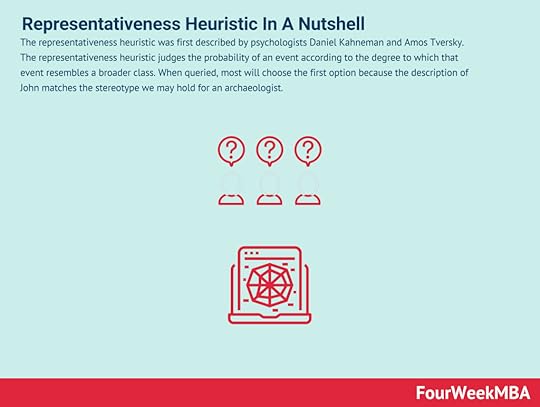 The representativeness heuristic was first described by psychologists Daniel Kahneman and Amos Tversky. The representativeness heuristic judges the probability of an event according to the degree to which that event resembles a broader class. When queried, most will choose the first option because the description of John matches the stereotype we may hold for an archaeologist.
The representativeness heuristic was first described by psychologists Daniel Kahneman and Amos Tversky. The representativeness heuristic judges the probability of an event according to the degree to which that event resembles a broader class. When queried, most will choose the first option because the description of John matches the stereotype we may hold for an archaeologist. The take-the-best heuristic is a decision-making shortcut that helps an individual choose between several alternatives. The take-the-best (TTB) heuristic decides between two or more alternatives based on a single good attribute, otherwise known as a cue. In the process, less desirable attributes are ignored.
The take-the-best heuristic is a decision-making shortcut that helps an individual choose between several alternatives. The take-the-best (TTB) heuristic decides between two or more alternatives based on a single good attribute, otherwise known as a cue. In the process, less desirable attributes are ignored. The concept of cognitive biases was introduced and popularized by the work of Amos Tversky and Daniel Kahneman since 1972. Biases are seen as systematic errors and flaws that make humans deviate from the standards of rationality, thus making us inept at making good decisions under uncertainty.
The concept of cognitive biases was introduced and popularized by the work of Amos Tversky and Daniel Kahneman since 1972. Biases are seen as systematic errors and flaws that make humans deviate from the standards of rationality, thus making us inept at making good decisions under uncertainty. The bundling bias is a cognitive bias in e-commerce where a consumer tends not to use all of the products bought as a group, or bundle. Bundling occurs when individual products or services are sold together as a bundle. Common examples are tickets and experiences. The bundling bias dictates that consumers are less likely to use each item in the bundle. This means that the value of the bundle and indeed the value of each item in the bundle is decreased.
The bundling bias is a cognitive bias in e-commerce where a consumer tends not to use all of the products bought as a group, or bundle. Bundling occurs when individual products or services are sold together as a bundle. Common examples are tickets and experiences. The bundling bias dictates that consumers are less likely to use each item in the bundle. This means that the value of the bundle and indeed the value of each item in the bundle is decreased. The Barnum Effect is a cognitive bias where individuals believe that generic information – which applies to most people – is specifically tailored for themselves.
The Barnum Effect is a cognitive bias where individuals believe that generic information – which applies to most people – is specifically tailored for themselves. Nudge theory argues positive reinforcement and indirect suggestion is an effective way to influence the behavior and decision making of individuals or groups. Nudge theory was an idea first popularized by behavioral economist Richard Thaler and political scientist Cass Sunstein. However, the pair based much of their theory on heuristic research conducted by psychologists Daniel Kahneman and Amos Tversky in the 1970s.
Nudge theory argues positive reinforcement and indirect suggestion is an effective way to influence the behavior and decision making of individuals or groups. Nudge theory was an idea first popularized by behavioral economist Richard Thaler and political scientist Cass Sunstein. However, the pair based much of their theory on heuristic research conducted by psychologists Daniel Kahneman and Amos Tversky in the 1970s. The bullwhip effect describes the increasing fluctuations in inventory in response to changing consumer demand as one moves up the supply chain. Observing, analyzing, and understanding how the bullwhip effect influences the whole supply chain can unlock important insights into various parts of it.
The bullwhip effect describes the increasing fluctuations in inventory in response to changing consumer demand as one moves up the supply chain. Observing, analyzing, and understanding how the bullwhip effect influences the whole supply chain can unlock important insights into various parts of it.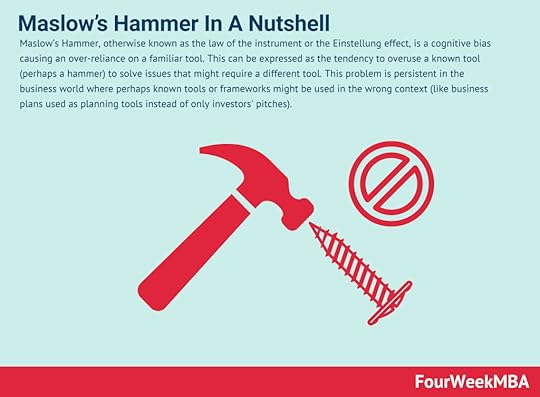 Maslow’s Hammer, otherwise known as the law of the instrument or the Einstellung effect, is a cognitive bias causing an over-reliance on a familiar tool. This can be expressed as the tendency to overuse a known tool (perhaps a hammer) to solve issues that might require a different tool. This problem is persistent in the business world where perhaps known tools or frameworks might be used in the wrong context (like business plans used as planning tools instead of only investors’ pitches).
Maslow’s Hammer, otherwise known as the law of the instrument or the Einstellung effect, is a cognitive bias causing an over-reliance on a familiar tool. This can be expressed as the tendency to overuse a known tool (perhaps a hammer) to solve issues that might require a different tool. This problem is persistent in the business world where perhaps known tools or frameworks might be used in the wrong context (like business plans used as planning tools instead of only investors’ pitches). The Abilene paradox was first introduced by management expert Jerry B. Harvey in a 1974 article entitled The Abilene Paradox: The Management of Agreement. The Abilene paradox occurs when a group of people collectively decide to act in a way that contradicts the preferences of most or all the individuals in the group.
The Abilene paradox was first introduced by management expert Jerry B. Harvey in a 1974 article entitled The Abilene Paradox: The Management of Agreement. The Abilene paradox occurs when a group of people collectively decide to act in a way that contradicts the preferences of most or all the individuals in the group.Main Free Guides:
Business ModelsBusiness StrategyBusiness DevelopmentDigital Business ModelsDistribution ChannelsMarketing StrategyPlatform Business ModelsRevenue ModelsTech Business ModelsBlockchain Business Models FrameworkThe post Constructive Paranoia: How To Leverage Constructive Paranoia To Avoid Ruin In Business appeared first on FourWeekMBA.
GitHub vs. GitLab: Business Models Compared
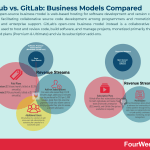
GitHub’s open-source business model is web-based hosting for software development and version control using Git, facilitating collaborative source code development among programmers and monetizing via premium and enterprise support. GitLab’s open-core business model instead is a collaborative code repository used to host and review code, build software, and manage projects, monetized primarily through its two paid plans (Premium & Ultimate) and via its subscription add-ons.
What are GitHub and GitLab?GitHub is a collaborative code repository used to host and review code, build software, and manage projects. The platform was founded in 2008 by Tom Preston-Warner, PJ Hyett, and Chris Wanstrath. At last count, GitHub hosted more than 238 million repositories.
 GitHub provides web-based hosting for software development and version control using Git, which facilitates collaborative source code development among programmers. GitHub was founded by Chris Wanstrath, P. J. Hyett, Tom Preston-Werner, and Scott Chacon in 2008. Microsoft acquired the company for $7.5 billion in 2018, and it was integrated as part of Microsoft’s enterprise offering. On top of its free repository, GitHub also offers plans for teams and enterprise customers. And the GitHub marketplace also monetizes on some of the apps developed on top of it.
GitHub provides web-based hosting for software development and version control using Git, which facilitates collaborative source code development among programmers. GitHub was founded by Chris Wanstrath, P. J. Hyett, Tom Preston-Werner, and Scott Chacon in 2008. Microsoft acquired the company for $7.5 billion in 2018, and it was integrated as part of Microsoft’s enterprise offering. On top of its free repository, GitHub also offers plans for teams and enterprise customers. And the GitHub marketplace also monetizes on some of the apps developed on top of it.GitLab is a similar repository manager allowing teams to collaborate on code, with the platform offering similar features for issue tracking and project management. GitLab was founded by Dmitriy Zaporozhets and Valery Sizov in 2011 and is used by enterprises such as IBM, Sony, and NASA.
 GitLab was created in 2013 by Ukrainian developers Dmitriy Zaporozhets, Valery Sizov, and Sytse Sijbrandij as a source code management solution for collaborative software teams. GitLab is a web-based, open-source DevOps tool providing issue-tracking and continuous integration and deployment pipeline features. It makes money via its main two paid plans (Premium & Ultimate) and via its subscription add-ons.
GitLab was created in 2013 by Ukrainian developers Dmitriy Zaporozhets, Valery Sizov, and Sytse Sijbrandij as a source code management solution for collaborative software teams. GitLab is a web-based, open-source DevOps tool providing issue-tracking and continuous integration and deployment pipeline features. It makes money via its main two paid plans (Premium & Ultimate) and via its subscription add-ons. In this article, we’ll take a look at some of the key similarities and differences between the two platforms.
Key similarities between GitHub and GitLabLet’s start by describing some of the similarities.
Version control and Git functionalityThe Git functionality and basic commands are more or less the same between GitHub and GitLab. Specifically:
Branch – users can create an independent development line using the brand command. This may be a developed version, a minor feature, or the master branch.
Fork – a fork is a copy of a specific code repository available for any developer to experiment with. It does not matter if they are an external contributor.
 In software engineering, a fork consists of a “split” of a project, as developers take the source code to start independently developing on it. Software protocols (the set of rules underlying the software) usually fork as a group decision-making process. All developers have to agree on the new course and direction of the software protocol. A fork can be “soft” when an alteration to the software protocol keeps it backward compatible or “hard” where a divergence of the new chain is permanent. Forks are critical to the development and evolution of Blockchain protocols.
In software engineering, a fork consists of a “split” of a project, as developers take the source code to start independently developing on it. Software protocols (the set of rules underlying the software) usually fork as a group decision-making process. All developers have to agree on the new course and direction of the software protocol. A fork can be “soft” when an alteration to the software protocol keeps it backward compatible or “hard” where a divergence of the new chain is permanent. Forks are critical to the development and evolution of Blockchain protocols.Pull/merge – these describe submissions of suggested code to an edited branch. A senior developer or QA team will test the code and approved changes are automatically integrated into the relevant branch. A pull request in GitHub is called a merge request in GitLab.
Collaboration and code managementBoth platforms incorporate built-in code review and collaborative tools as part of their free versions. Users can, as an example, view and discuss pull requests in real-time and view a complete overview of code differences.
Both platforms also offer project management tools. In GitLab, users can create logical issue hierarchies and assign different developers to various branches. Similar functionality is offered in GitHub with issue categorization, milestone and productivity tracking, and various reports and charts.
Business model, plans, and supportAt the time of writing, both platforms work under a freemium business model. Users on a free plan get access to unlimited public and private repositories. However, access to advanced security, compliance, and management features is restricted to paid plans.
In comparing the plans offered by GitLab and GitHub, there exist no appreciable differences in the level of support offered. The same can also be said for features. But in limited situations, GitHub users may need to use an app or third-party integration to get the same level of functionality as a GitLab user. We will revisit this difference in the next section.
Worth mentioning that back in 2018, Microsoft acquired GitHub for over $7 billion. For some context. For Microsoft in 2021, Enterprise Services revenue increased $534 million or 8% driven by growth in Premier Support Services.
One example is how Microsoft’s GitHub monetizes through premium/enterprise support

Through what they call premium perks:

A great example of support plans for enterprise products with a freemium/open-source model:
 Key differences between GitHub and GitLab
Key differences between GitHub and GitLabUltimately, key differences between the two platforms will be the driving force behind consumer purchasing decisions.
With that in mind, consider the main differences between GitHub and GitLab below.
CI/CD IntegrationGitLab has a dominant market share in CI/CD Integration, with GitHub only adding GitHub Actions in the latter stages of 2019. This point is perhaps the biggest difference in user experience between the two platforms.
GitLab CI lets users build, stage, and deploy code automatically using a DevOps workflow. There is no need to rely on manual updates or custom-build integrations.
Those with limited experience in CI/CD pipelines enjoy GitLab’s integrated tool because it requires very little setup. GitLab CI/CD also features built-in security scanning and collaboration and offers an integrated container registry.
These features are not available in the competing GitHub product, with developers instead forced to work with a third-party tool such as TravisCI.
Community aspectGitHub has been in operation for longer than GitLab, so its users tend to be far more proficient in the platform.
With a larger, open-source community, GitHub offers a diverse range of repositories that are unmatched elsewhere. There are also millions of active users on the platform actively working to solve problems and share ideas.
WorkflowWhile most of the underlying technology and features are basically identical, the recommended workflow across GitHub and GitLab differ substantially.
GitHub advocates speed with a feature-focused development approach to merge new branches with the master branch. This makes it ideal for Agile projects. GitHub’s business model is primarily open-source-based.
 Open source is licensed and usually developed and maintained by a community of independent developers. While the freemium is developed in-house. Thus the freemium give the company that developed it, full control over its distribution. In an open-source model, the for-profit company has to distribute its premium version per its open-source licensing model.
Open source is licensed and usually developed and maintained by a community of independent developers. While the freemium is developed in-house. Thus the freemium give the company that developed it, full control over its distribution. In an open-source model, the for-profit company has to distribute its premium version per its open-source licensing model.GitLab, on the other hand, advocates reliability. Users can create multiple stable branches beyond the master in production and pre-production. Organizations with a dedicated quality assurance team favor this approach because it lets their R&D teams work on new features without the hassle of testing every single code change. GitLab business model can be defined as an open core, as it prioritizes project management effectiveness.
 While the term has been coined by Andrew Lampitt, open-core is an evolution of open-source. Where a core part of the software/platform is offered for free, while on top of it are built premium features or add-ons, which get monetized by the corporation who developed the software/platform. An example of the GitLab open core model, where the hosted service is free and open, while the software is closed. Key takeaways:Both GitLab and GitHub are code development platforms with a core focus on the open-source Git system. Both platforms have basically the same functionality and version control. Both also incorporate built-in code review and collaborative tools as part of their free versions.Free users on both platforms get access to unlimited public and private repositories. Access to advanced security, compliance, and management features is restricted to multiple, paid individual and enterprise solutions.Key differences between GitLab and GitHub include the degree of CI/CD integration, with GitLab users able to avoid manual updates and sometimes clunky custom builds. However, GitHub’s pedigree as an open-source developer platform means it has a stronger and more collaborative community.
While the term has been coined by Andrew Lampitt, open-core is an evolution of open-source. Where a core part of the software/platform is offered for free, while on top of it are built premium features or add-ons, which get monetized by the corporation who developed the software/platform. An example of the GitLab open core model, where the hosted service is free and open, while the software is closed. Key takeaways:Both GitLab and GitHub are code development platforms with a core focus on the open-source Git system. Both platforms have basically the same functionality and version control. Both also incorporate built-in code review and collaborative tools as part of their free versions.Free users on both platforms get access to unlimited public and private repositories. Access to advanced security, compliance, and management features is restricted to multiple, paid individual and enterprise solutions.Key differences between GitLab and GitHub include the degree of CI/CD integration, with GitLab users able to avoid manual updates and sometimes clunky custom builds. However, GitHub’s pedigree as an open-source developer platform means it has a stronger and more collaborative community.Read Next: GitHub Business Model, GitLab Business Model, Open-Source Business Model, Open Core Business Model.
Main Free Guides:
Business ModelsBusiness StrategyBusiness DevelopmentDigital Business ModelsDistribution ChannelsMarketing StrategyPlatform Business ModelsRevenue ModelsTech Business ModelsBlockchain Business Models FrameworkThe post GitHub vs. GitLab: Business Models Compared appeared first on FourWeekMBA.
November 16, 2021
How Does Vivino Make Money? The Vivino Business Model In A Nutshell
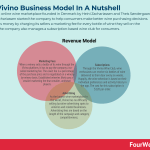
Vivino is an online wine marketplace founded in Denmark by Heini Zachariassen and Theis Søndergaard in 2010. Zachariassen started the company to help consumers make better wine purchasing decisions. Vivino earns money by charging its sellers a marketing fee for every bottle of wine they sell on the platform. The company also manages a subscription-based wine club for consumers. Vivino sells advertising spots and consumer aggregate data to interested parties. The popularity of both options is likely to be enhanced by the vast size of the Vivino marketplace and user base.
History of VivinoVivino is an online wine marketplace with an app for Android and Apple devices. The company was founded in Denmark by Heini Zachariassen and Theis Søndergaard in 2010.
Zachariassen started the company to solve a problem many consumers face when choosing a bottle of wine: determining the good from the bad amongst the hundreds of different brands for sale.
Though smartphone apps were just beginning to take off, there were almost 1,000 existing wine apps available when Vivino was launched in 2010. Many were run by industry experts, but Zachariassen and Søndergaard were unfazed. Their strategy from the beginning was to build the largest wine database in the world while remaining steadfast to their mission to help consumers make better purchasing decisions.
To build their marketplace, Vivino sent wine labels to India where 50 people manually researched information about those wines and added it to the app. This process continued for 18 months until there was a 70% chance that a consumer could find reviews about a bottle of wine in the Vivino database.
At this point, the company had achieved critical mass. Vivino’s commitment to serving its users who were wine enthusiasts but not wine experts gave it a critical point of differentiation in the market. Vivino also listened to its audience and helped them understand the various wines they were interested in. This high-level engagement increased the likelihood a user would purchase a bottle of wine and leave a review.
By 2017, the platform had enough user data with which to make recommendations. To that end, Zachariassen and Søndergaard built a machine learning tool that read all the user reviews on a particular wine and compiled a structured description of its taste. This led to some calling Vivino the “Netflix of wine”.
Vivino now claims to be the world’s largest online wine marketplace and the most downloaded wine app. The platform features almost 79 million user reviews on more than 14 million wines.
Vivino revenue generationVivino works on the marketplace business model, matching the supply of wine from wineries with the demand from consumers.
The company has several revenue generation strategies, with each listed below.
Marketing feesWhen a winery sells a bottle of its wine through the Vivino platform, it has to pay the company a so-called marketing fee.
The exact fee is a percentage of the purchase price and is negotiated on a winery-by-winery basis. Established wineries likely pay a smaller marketing fee than smaller, unknown players.
SubscriptionsThrough the Vivino Wine Club, wine enthusiasts can receive six bottles of wine delivered to their door every six weeks. Happily, the wine selection is based on their individual preferences and activity history in the app.
The cost for this subscription is $120 per order.
AdvertisingAs the largest wine marketplace in the world, Vivino has no difficulty selling lucrative advertising spots to wineries and related businesses.
Advertising fees are based on the length of the campaign and category competitiveness.
Consumer aggregate dataVivino also collects vast amounts of consumer purchasing behavior data. This information helps guide the merchandising strategies of various wineries and wine retailers who pay Vivino for access and exposure.
Main Free Guides:
Business ModelsBusiness StrategyBusiness DevelopmentDigital Business ModelsDistribution ChannelsMarketing StrategyPlatform Business ModelsRevenue ModelsTech Business ModelsBlockchain Business Models FrameworkThe post How Does Vivino Make Money? The Vivino Business Model In A Nutshell appeared first on FourWeekMBA.
How Does OpenSea Make Money? The OpenSea Business Model In A Nutshell
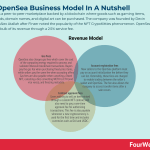
OpenSea is a peer-to-peer marketplace backed by a blockchain where goods such as gaming items, trading cards, domain names, and digital art can be purchased. The company was founded by Devin Finzer and Alex Atallah after Finzer noted the popularity of the NFT CrypoKitties phenomenon. OpenSea makes the bulk of its revenue through a 2.5% service fee. The fee is collected whenever a NFT is sold on the platform. OpenSea charges gas fees to buyers and sellers to cover the cost of applicable blockchain transactions. There are also account registration and contract approval fees when a new account is opened and a new cryptocurrency is used, respectively.
History of OpenSeaOpenSea is a peer-to-peer marketplace backed by a blockchain where goods such as gaming items, trading cards, domain names, and digital art can be purchased.
The company was founded in 2017 by Devin Finzer and Alex Atallah at a time when non-fungible token (NFT) projects were just starting to attract interest. Finzer became interested in NFTs after witnessing the CryptoKitties project, a tech culture phenomenon where people were paying hundreds of thousands of dollars for collectible video game cats. More broadly speaking, Finzer also wondered if there was more to crypto than simply finance and currencies.
A few months later, he teamed up with software developer Atallah, a Stanford graduate who also had a burgeoning interest in cryptocurrency. They presented a rough idea to a Techcrunch Hackathon in September and were then accepted into the Y Combinator program to take the project further. After an initial pivot, Finzer and Atallah returned to CrypoKitties and its underlying infrastructure. Using something similar, they decided to build a digital marketplace where users could buy or sell NFTs in multiple categories. The OpenSea platform launched in February 2018, describing itself as “eBay for cryptogoods.”
Initially, the OpenSea marketplace relied on game developers to drive business – though new categories were continuously added. The company managed to secure a $2 million round of funding early and in December, acquired competitor marketplace Atomic Bazaar. By the end of 2019, OpenSea was considered to be the leading NFT marketplace.
This position was solidified after the COVID-19 pandemic forced people to stay at home, with the NFT market itself experiencing rapid growth. In fact, NFT sales for 2020 were $94.8 million, equivalent to 30,000% year-on-year growth. During this time, the company had just seven employees and struggled to scale its operations to meet demand.
OpenSea is on track to surpass $27.5 billion in sales volume for 2021 with average daily fee revenue amounting to $4.2 million.
OpenSea revenue generationOpenSea has a rather simple revenue generation strategy.
The company makes most of its money by charging service fees whenever a digital asset is sold on its platform.
The service fee is 2.5%, which means an NFT selling for $200 earns OpenSea $5.
Gas feesOpenSea also charges gas fees which cover the cost of the computing energy required to process and validate Ethereum blockchain transactions.
Buyers pay the gas fee when purchasing fixed-price items, while sellers pay the same fee when accepting offers.
Gas fees are also payable when canceling a listed NFT, canceling a bid, converting WETH to ETH (and vice versa), and freezing metadata.
Account registration feesNew sellers to the OpenSea platform must pay an account initialization fee before they can list.
Ostensibly, these fees are charged to enable trading between the seller’s wallet and OpenSea. The fee also allows the company to access transfer items after a sale occurs.
Contract approval feesUsers wishing to sell an item minted through a custom NFT contract will also need to pay a one-time approval fee for authorizing transactions.
This fee is also payable whenever a new cryptocurrency is used for the first time and includes currencies such as DAI and USDC.
Connected Business Concepts According to Joel Monegro, a former analyst at USV (a venture capital firm) the blockchain implies value creation in its protocols. Where the web has allowed the value to be captured at the applications layer (take Facebook, Twitter, Google, and many others). In a Blockchain Economy, this value might be captured by the protocols at the base of the blockchain (for instance Bitcoin and Ethereum). However, according to blockchain investor Paivinen due to ease of forking, incentives to compete and improved interoperability and interchangeability also in a blockchain-based economy, protocols might get thinner. Although the marginal value of scale might be lower compared to a web-based economy, where massive scale created an economic advantage. The success of the Blockchain will depend on its commercial viability!
According to Joel Monegro, a former analyst at USV (a venture capital firm) the blockchain implies value creation in its protocols. Where the web has allowed the value to be captured at the applications layer (take Facebook, Twitter, Google, and many others). In a Blockchain Economy, this value might be captured by the protocols at the base of the blockchain (for instance Bitcoin and Ethereum). However, according to blockchain investor Paivinen due to ease of forking, incentives to compete and improved interoperability and interchangeability also in a blockchain-based economy, protocols might get thinner. Although the marginal value of scale might be lower compared to a web-based economy, where massive scale created an economic advantage. The success of the Blockchain will depend on its commercial viability!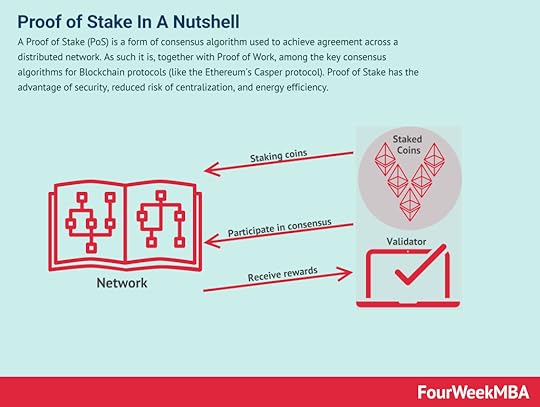 A Proof of Stake (PoS) is a form of consensus algorithm used to achieve agreement across a distributed network. As such it is, together with Proof of Work, among the key consensus algorithms for Blockchain protocols (like the Ethereum’s Casper protocol). Proof of Stake has the advantage of security, reduced risk of centralization, and energy efficiency.
A Proof of Stake (PoS) is a form of consensus algorithm used to achieve agreement across a distributed network. As such it is, together with Proof of Work, among the key consensus algorithms for Blockchain protocols (like the Ethereum’s Casper protocol). Proof of Stake has the advantage of security, reduced risk of centralization, and energy efficiency.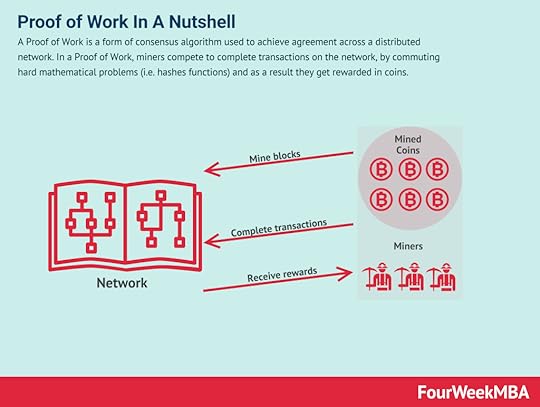 A Proof of Work is a form of consensus algorithm used to achieve agreement across a distributed network. In a Proof of Work, miners compete to complete transactions on the network, by commuting hard mathematical problems (i.e. hashes functions) and as a result they get rewarded in coins.
A Proof of Work is a form of consensus algorithm used to achieve agreement across a distributed network. In a Proof of Work, miners compete to complete transactions on the network, by commuting hard mathematical problems (i.e. hashes functions) and as a result they get rewarded in coins.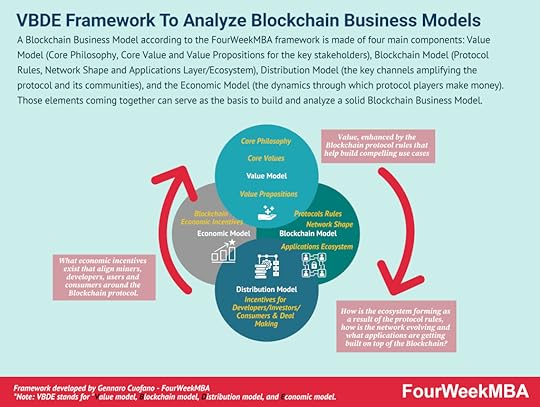 A Blockchain Business Model according to the FourWeekMBA framework is made of four main components: Value Model (Core Philosophy, Core Values and Value Propositions for the key stakeholders), Blockchain Model (Protocol Rules, Network Shape and Applications Layer/Ecosystem), Distribution Model (the key channels amplifying the protocol and its communities), and the Economic Model (the dynamics/incentives through which protocol players make money). Those elements coming together can serve as the basis to build and analyze a solid Blockchain Business Model.
A Blockchain Business Model according to the FourWeekMBA framework is made of four main components: Value Model (Core Philosophy, Core Values and Value Propositions for the key stakeholders), Blockchain Model (Protocol Rules, Network Shape and Applications Layer/Ecosystem), Distribution Model (the key channels amplifying the protocol and its communities), and the Economic Model (the dynamics/incentives through which protocol players make money). Those elements coming together can serve as the basis to build and analyze a solid Blockchain Business Model. Ethereum was launched in 2015 with its cryptocurrency, Ether, as an open-source, blockchain-based, decentralized platform software. Smart contracts are enabled, and Distributed Applications (dApps) get built without downtime or third-party disturbance. It also helps developers build and publish applications as it is also a programming language running on a blockchain.
Ethereum was launched in 2015 with its cryptocurrency, Ether, as an open-source, blockchain-based, decentralized platform software. Smart contracts are enabled, and Distributed Applications (dApps) get built without downtime or third-party disturbance. It also helps developers build and publish applications as it is also a programming language running on a blockchain. The Graph is an ERC20 Utility Token (built on top of Ethereum) to enable consumers to freely query the blockchain through a fully decentralized database kept by indexers, incentivized by the payment of tokens (called GRT). The network is also ministered by curators and delegators that help maintain a high-quality index.
The Graph is an ERC20 Utility Token (built on top of Ethereum) to enable consumers to freely query the blockchain through a fully decentralized database kept by indexers, incentivized by the payment of tokens (called GRT). The network is also ministered by curators and delegators that help maintain a high-quality index. BAT or Basic Attention Token is a utility token aiming to provide privacy-based web tools for advertisers and users to monetize attention on the web in a decentralized way via Blockchain-based technologies. Therefore, the BAT ecosystem moves around a browser (Brave), a privacy-based search engine (Brave Search), and a utility token (BAT). Users can opt-in to advertising, thus making money based on their attention to ads as they browse the web.
BAT or Basic Attention Token is a utility token aiming to provide privacy-based web tools for advertisers and users to monetize attention on the web in a decentralized way via Blockchain-based technologies. Therefore, the BAT ecosystem moves around a browser (Brave), a privacy-based search engine (Brave Search), and a utility token (BAT). Users can opt-in to advertising, thus making money based on their attention to ads as they browse the web. In 2012, co-founders Christian Larsen and Jed McCaleb created Ripple, a technology acting as both a pre-mined cryptocurrency called XRP and a digital payment platform enabling monetary transactions. Where Ripple is the tech company, XRP is the decentralized ledger.
In 2012, co-founders Christian Larsen and Jed McCaleb created Ripple, a technology acting as both a pre-mined cryptocurrency called XRP and a digital payment platform enabling monetary transactions. Where Ripple is the tech company, XRP is the decentralized ledger. In 2014, Jed McCaleb – which also played a key role in the development of Ripple – created a cryptocurrency to provide fast, reliable, and affordable money transactions. The same cryptocurrency has considerably grown seven years later. It is now one of the most stellar cryptocurrencies to provide a real-time platform that links banks, payment systems, and people. Meet, Stellar!
In 2014, Jed McCaleb – which also played a key role in the development of Ripple – created a cryptocurrency to provide fast, reliable, and affordable money transactions. The same cryptocurrency has considerably grown seven years later. It is now one of the most stellar cryptocurrencies to provide a real-time platform that links banks, payment systems, and people. Meet, Stellar! In early 2019, a joint project between TRON and BitTorrent Foundation called BitTorrent Token came to fruition. BitTorrent Token launched to tokenize in-demand file-sharing protocol and enhance content delivery and bandwidth accessibility with blockchain technology.
In early 2019, a joint project between TRON and BitTorrent Foundation called BitTorrent Token came to fruition. BitTorrent Token launched to tokenize in-demand file-sharing protocol and enhance content delivery and bandwidth accessibility with blockchain technology. Chainlink is considered the most established decentralized oracle network. As an ecosystem housing several decentralized oracle networks running simultaneously. As a decentralized oracle service built on Ethereum, Chainlink has the power to support the development of blockchain solutions for both traditional businesses and enterprises.
Chainlink is considered the most established decentralized oracle network. As an ecosystem housing several decentralized oracle networks running simultaneously. As a decentralized oracle service built on Ethereum, Chainlink has the power to support the development of blockchain solutions for both traditional businesses and enterprises. Uniswap is a renowned decentralized crypto exchange created in 2018 and based on the Ethereum blockchain, to provide liquidity to the system. As a cryptocurrency exchange technology that operates on a decentralized basis. The Uniswap protocol inherited its namesake from the business that created it — Uniswap. Through smart contracts, the Uniswap protocol automates transactions between cryptocurrency tokens on the Ethereum blockchain.
Uniswap is a renowned decentralized crypto exchange created in 2018 and based on the Ethereum blockchain, to provide liquidity to the system. As a cryptocurrency exchange technology that operates on a decentralized basis. The Uniswap protocol inherited its namesake from the business that created it — Uniswap. Through smart contracts, the Uniswap protocol automates transactions between cryptocurrency tokens on the Ethereum blockchain. In essence, Polkadot is a cryptocurrency project created as an effort to transform and power a decentralized internet, Web 3.0, in the future. Polkadot is a decentralized platform, which makes it interoperable with other blockchains.
In essence, Polkadot is a cryptocurrency project created as an effort to transform and power a decentralized internet, Web 3.0, in the future. Polkadot is a decentralized platform, which makes it interoperable with other blockchains. Designed and created as an alternative to Ethereum, Cardano claims to be the first decentralized blockchain protocol to use a scientific approach and undergo a peer evaluation.
Designed and created as an alternative to Ethereum, Cardano claims to be the first decentralized blockchain protocol to use a scientific approach and undergo a peer evaluation. Solana is a blockchain network with a focus on high performance and rapid transactions. To boost speed, it employs a one-of-a-kind approach to transaction sequencing. Users can use SOL, the network’s native cryptocurrency, to cover transaction costs and engage with smart contracts.
Solana is a blockchain network with a focus on high performance and rapid transactions. To boost speed, it employs a one-of-a-kind approach to transaction sequencing. Users can use SOL, the network’s native cryptocurrency, to cover transaction costs and engage with smart contracts.Get The 450 Pages Blockchain Business Models Book

Read Also: Proof-of-stake, Proof-of-work, Bitcoin, Dogecoin, Ethereum, Solana, Blockchain, BAT, Monero, Ripple, Litecoin, Stellar, Dogecoin, Bitcoin Cash, Filecoin.
Main Free Guides:
Business ModelsBusiness StrategyBusiness DevelopmentDigital Business ModelsDistribution ChannelsMarketing StrategyPlatform Business ModelsRevenue ModelsTech Business ModelsBlockchain Business Models FrameworkThe post How Does OpenSea Make Money? The OpenSea Business Model In A Nutshell appeared first on FourWeekMBA.
What Is The Abilene paradox? The Abilene Paradox In A Nutshell
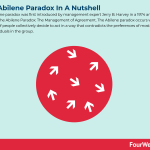
The Abilene paradox was first introduced by management expert Jerry B. Harvey in a 1974 article entitled The Abilene Paradox: The Management of Agreement. The Abilene paradox occurs when a group of people collectively decide to act in a way that contradicts the preferences of most or all the individuals in the group.
Understanding the Abilene paradoxIn the article, Harvey recounted the parable which gave the paradox its name. On a hot today in Coleman, Texas, a husband, wife, and her parents were sitting on the porch quite comfortably sipping lemonade. The father-in-law suggest driving 53 miles to Abilene to eat at a cafeteria, a suggestion the other three decided to go along with despite feeling apprehensive.
The travel to Abilene in a car without air conditioning was unpleasant, and the meal at the cafeteria wasn’t particularly appetizing either. On their way back to Coleman, the members of the group complained about the decision to go to Abilene. Despite their initial opposition, the individuals went along with the idea because they didn’t want to upset anyone.
Why does the Abilene paradox occur?The Abilene paradox occurs because of a fundamental inability to manage agreement. Each member mistakenly believes their preferences differ from the rest of the group and as a consequence, does not raise any objections. This is a major problem in organizations that have become so adept at managing conflict that the skill of managing agreement is underdeveloped or absent.
Favoring agreement over speaking up can be explained by various aspects of social psychology, including theories relating to social conformity and social influence. These theories suggest individuals are extremely averse to acting in a way that contravenes the prevailing actions of a group.
Individual aversiveness, in turn, might be explained by what Harvey called “negative fantasies”. Here, the individual experiences unpleasant visualizations detailing how the group may act if they are honest with their thoughts or feelings. In situations with a palpable or realistic chance of the group excluding them entirely, the individual may pre-emptively experience separation anxiety.
Symptoms of the Abilene paradox in an organizational contextFailing to manage agreement may not seem like such a bad thing at first glance, but it can have serious implications for a company.
Following is a look at the six symptoms of the paradox as described by Harvey himself:
Employees agree as to the nature of a problem or situation facing the organization. However, they agree privately without informing others.Employees also agree as to the steps required to rectify the problem or situation. In the Abilene parable, maintaining the status quo by remaining on the porch sipping lemonade would have satisfied individual and group needs. This agreement is also made privately.Private agreement causes employees to fail to communicate their desires and beliefs to one another. This causes every other member of the group to misperceive the collective reality. This misperception then causes each individual to act contrary to their desires with inaccurate and invalid information. In a business context, employees act in ways that are counterproductive to organizational purpose, intent, and success.Counterproductive actions then causes employee frustration and anger as employees become dissatisfied with the organization. They tend to form subgroups with trusted acquaintances and direct their grievances toward other subgroups and authority figures.If the ability to manage agreement is absent, the cycle repeats itself with greater intensity. In the Abilene parable, the group became conscious of the paradox, thereby ensuring their problems did not intensify.Avoiding the Abilene paradox
Here are three ways to avoid the negative impacts of the paradox in any organization:
Create a safe environment – if the individual is reluctant to share an opposing view, then they must be encouraged by creating an environment where it is safe to do so. Specifically, there should be a culture of trust, collaboration, and empathy with team leaders setting the example.Actively listen to feedback – opinions that go against the grain must be actively considered by leadership. This helps diffuse potential conflict before it has the chance to undermine the organization. It also helps avoid a situation where employees become cynical about their chances of being heard or instituting change. Diversity of input and opinion is key, no matter how unpopular or unconventional.Expect disagreement – it is important to consider disagreement as a healthy by-product of teams with diverse perspectives. In collaborative organizations, disagreement is analyzed to enrich and validate the final decision.Key takeaways:The Abilene paradox occurs when a group of people collectively decide to act in a way that contradicts the preferences of most or all the individuals in the group.The Abilene paradox occurs because of a fundamental inability to manage agreement. Each member mistakenly believes their preferences differ from the rest of the group and as a consequence, is fearful of voicing their concerns. This inability to raise objections is rooted in aspects of social influence and social conformity theory.Avoiding the Abilene paradox in organizations means creating a safe environment, actively listening to feedback, and reframing disagreement as a function of healthy and diverse teams.Main Guides:
Business ModelsBusiness StrategyBusiness DevelopmentDistribution ChannelsMarketing StrategyPlatform Business ModelsNetwork EffectsRelated Business Concepts As highlighted by German psychologist Gerd Gigerenzer in the paper “Heuristic Decision Making,” the term heuristic is of Greek origin, meaning “serving to find out or discover.” More precisely, a heuristic is a fast and accurate way to make decisions in the real world, which is driven by uncertainty.
As highlighted by German psychologist Gerd Gigerenzer in the paper “Heuristic Decision Making,” the term heuristic is of Greek origin, meaning “serving to find out or discover.” More precisely, a heuristic is a fast and accurate way to make decisions in the real world, which is driven by uncertainty. The recognition heuristic is a psychological model of judgment and decision making. It is part of a suite of simple and economical heuristics proposed by psychologists Daniel Goldstein and Gerd Gigerenzer. The recognition heuristic argues that inferences are made about an object based on whether it is recognized or not.
The recognition heuristic is a psychological model of judgment and decision making. It is part of a suite of simple and economical heuristics proposed by psychologists Daniel Goldstein and Gerd Gigerenzer. The recognition heuristic argues that inferences are made about an object based on whether it is recognized or not. The representativeness heuristic was first described by psychologists Daniel Kahneman and Amos Tversky. The representativeness heuristic judges the probability of an event according to the degree to which that event resembles a broader class. When queried, most will choose the first option because the description of John matches the stereotype we may hold for an archaeologist.
The representativeness heuristic was first described by psychologists Daniel Kahneman and Amos Tversky. The representativeness heuristic judges the probability of an event according to the degree to which that event resembles a broader class. When queried, most will choose the first option because the description of John matches the stereotype we may hold for an archaeologist. The take-the-best heuristic is a decision-making shortcut that helps an individual choose between several alternatives. The take-the-best (TTB) heuristic decides between two or more alternatives based on a single good attribute, otherwise known as a cue. In the process, less desirable attributes are ignored.
The take-the-best heuristic is a decision-making shortcut that helps an individual choose between several alternatives. The take-the-best (TTB) heuristic decides between two or more alternatives based on a single good attribute, otherwise known as a cue. In the process, less desirable attributes are ignored. The concept of cognitive biases was introduced and popularized by the work of Amos Tversky and Daniel Kahneman since 1972. Biases are seen as systematic errors and flaws that make humans deviate from the standards of rationality, thus making us inept at making good decisions under uncertainty.
The concept of cognitive biases was introduced and popularized by the work of Amos Tversky and Daniel Kahneman since 1972. Biases are seen as systematic errors and flaws that make humans deviate from the standards of rationality, thus making us inept at making good decisions under uncertainty. The bundling bias is a cognitive bias in e-commerce where a consumer tends not to use all of the products bought as a group, or bundle. Bundling occurs when individual products or services are sold together as a bundle. Common examples are tickets and experiences. The bundling bias dictates that consumers are less likely to use each item in the bundle. This means that the value of the bundle and indeed the value of each item in the bundle is decreased.
The bundling bias is a cognitive bias in e-commerce where a consumer tends not to use all of the products bought as a group, or bundle. Bundling occurs when individual products or services are sold together as a bundle. Common examples are tickets and experiences. The bundling bias dictates that consumers are less likely to use each item in the bundle. This means that the value of the bundle and indeed the value of each item in the bundle is decreased. The Barnum Effect is a cognitive bias where individuals believe that generic information – which applies to most people – is specifically tailored for themselves.
The Barnum Effect is a cognitive bias where individuals believe that generic information – which applies to most people – is specifically tailored for themselves. Nudge theory argues positive reinforcement and indirect suggestion is an effective way to influence the behavior and decision making of individuals or groups. Nudge theory was an idea first popularized by behavioral economist Richard Thaler and political scientist Cass Sunstein. However, the pair based much of their theory on heuristic research conducted by psychologists Daniel Kahneman and Amos Tversky in the 1970s.
Nudge theory argues positive reinforcement and indirect suggestion is an effective way to influence the behavior and decision making of individuals or groups. Nudge theory was an idea first popularized by behavioral economist Richard Thaler and political scientist Cass Sunstein. However, the pair based much of their theory on heuristic research conducted by psychologists Daniel Kahneman and Amos Tversky in the 1970s. The bullwhip effect describes the increasing fluctuations in inventory in response to changing consumer demand as one moves up the supply chain. Observing, analyzing, and understanding how the bullwhip effect influences the whole supply chain can unlock important insights into various parts of it.
The bullwhip effect describes the increasing fluctuations in inventory in response to changing consumer demand as one moves up the supply chain. Observing, analyzing, and understanding how the bullwhip effect influences the whole supply chain can unlock important insights into various parts of it.  Maslow’s Hammer, otherwise known as the law of the instrument or the Einstellung effect, is a cognitive bias causing an over-reliance on a familiar tool. This can be expressed as the tendency to overuse a known tool (perhaps a hammer) to solve issues that might require a different tool. This problem is persistent in the business world where perhaps known tools or frameworks might be used in the wrong context (like business plans used as planning tools instead of only investors’ pitches).
Maslow’s Hammer, otherwise known as the law of the instrument or the Einstellung effect, is a cognitive bias causing an over-reliance on a familiar tool. This can be expressed as the tendency to overuse a known tool (perhaps a hammer) to solve issues that might require a different tool. This problem is persistent in the business world where perhaps known tools or frameworks might be used in the wrong context (like business plans used as planning tools instead of only investors’ pitches). The post What Is The Abilene paradox? The Abilene Paradox In A Nutshell appeared first on FourWeekMBA.
VR Companies: Top VR Companies To Track To Understand The Progress Of The VR Industry
Once the domain of science fiction, the simulated experience of virtual reality can now be found in entertainment, gaming, medical and military training, engineering, and business, among other applications. Most virtual reality systems utilize either virtual reality headsets or multi-projected environments that generate realistic images. VR technology is becoming faster, lighter, and more affordable as smartphone capabilities and the wireless 5G network makes it more accessible. The virtual reality market is expected to be worth billions in the coming decade, with the market comprised of hardware technology and the software that underpins the immersive virtual experience.
iTechArt GroupiTechArt is a custom software developer helping businesses implement augmented and immersive experiences. The company claims it can transform any field into a virtual reality experience, including training, communication, customer service, automotive, and cultural study.
iTechArt also creates mixed reality content, where physical and digital worlds collide to form contextually aware spatial experiences. The company is also a leader in 360-degree video and 3D rendering, with the latter used in panoramas, animation, and walkthroughs.
Oculus VROculus is a producer of the Oculus Rift and Oculus Quest line of virtual reality headsets. The company, which began with a Kickstarter campaign to make VR headsets available to developers, was acquired by Facebook in 2016 for $2 billion.
Such is the pedigree of Oculus headsets that many other companies use them as the basis for their own virtual reality products.
HTC CorporationHTC Corporation is also a manufacturer of virtual reality headsets.
The HTC Vive is one of the company’s defining products, with many fans suggesting it is a combination of The Matrix, Ready Player One, and the cyberpunk genre. The headset is also popular because it allows the user to freely walk around an area and not be constricted to a stationary position.
Under the HTC VIVE Arts banner, the headsets have also been incorporated into museum, gallery, and institution tours.
NvidiaNvidia is an American tech company best known for its graphics processing units and chips for the mobile computing and automotive market. However, the company also offers VR-enabled drivers, GPUs, and SDKs at the forefront of a new industry called visual computing.
Some of Nvidia’s specific innovations include bidirectional audio for immersive experiences and the creation of complex materials and high-resolution textures in VR design. The company has also partnered with Google Cloud to develop NVIDIA CloudXR, an optimized, high-quality user experience for remotely streamed VR.
SpatialSpatial helps bring together teams in a virtual space and is one of many companies to benefit from pandemic-induced remote working.
The company’s 3D collaboration space lets employees represent themselves in a virtual work area using avatars – regardless of their location. The face of each avatar is crafted from the face of the employee, increasing collaboration and team cohesiveness.
Key takeaways:iTechArt is a custom software developer helping businesses implement augmented and immersive experiences. The company claims it can transform almost experience into a virtual reality experience.Oculus is perhaps the most recognized manufacturer of VR headsets, with many other companies in the industry utilizing its products. The company was acquired by Facebook in 2016.HTC Corporation is another virtual reality company specializing in gaming, museums, institutions, and galleries. The HTC Vive headset has won praise for its ability to let the user walk around the room and not be constrained to a stationary position.Main Free Guides:
Business ModelsBusiness StrategyBusiness DevelopmentDigital Business ModelsDistribution ChannelsMarketing StrategyPlatform Business ModelsTech Business ModelThe post VR Companies: Top VR Companies To Track To Understand The Progress Of The VR Industry appeared first on FourWeekMBA.
Amazon Failures: The Top Amazon Failed Products
CEO Jeff Bezos once quipped that Amazon was “the best place in the world to fail.” Indeed, the billionaire entrepreneur has instilled a corporate culture where failure is not only acceptable but a necessary part of doing business. We’ll take a look at some of Amazon’s most spectacular failures, some of which cost the company billions in lost dollars.
Fire PhoneThe Fire Phone was released in July 2014 to compete with the smartphones offered by Apple and Samsung, among others. At first glance, the Fire Phone seemed a natural extension of Amazon’s highly successful Kindle, tablets, and streaming devices.
However, the Fire Phone failed to sell for $200 on a two-year contract. Dropping the price to 99 cents also failed to spark buyer interest.
The Fire Phone failed because Amazon was too late to the smartphone industry. The phone itself was overpriced and, aside from a revolutionary three-dimensional screen, did not offer anything novel or beneficial.
While the Fire Phone floundered, its voice recognition feature did lead to the development of the voice assistant Alexa.
Amazon DestinationsAmazon Destinations was a service enabling consumers to book a last-minute vacation at a hotel within driving distance of their home.
The service was established to profit from the popularity of short strips in the United States, with more than 40% of all vacations comprising stays of one to three nights.
A few months after launch, Amazon Destinations was shut down, with the company providing no official reason for its demise. Industry representatives suggest increased competition from the likes to Expedia may have been to blame. Others posit that succeeding in the hotel reservation business would have required the full attention of the company.
Pets.comAmazon’s investment in Pets.com is perhaps its most notable product investment failure.
In March 1999, the company acquired a 54% stake in Pets.com worth around $10.5 million.
However, Pets.com would become yet another victim of the dot-com bubble burst a year later.
Amazon WalletAmazon Wallet debuted in 2014, allowing users to save vouchers and loyalty cards on their smartphones to pay for Amazon goods and services.
The service failed to gain significant traction and experienced a lukewarm response, especially when compared to Apple Pay which launched a few months later. The service also relied on QR codes to make purchases – consumers could not use a credit or debit card.
What’s more, many retailers chose not to accept Amazon Wallet as a form of payment since the eCommerce giant was a major competitor.
Amazon RestaurantsAmazon Restaurants was a service delivering freshly prepared food from local restaurants to consumers via the company’s same-day delivery network. Launched in 2015, the service was shut down four years later in June 2019.
Amazon Restaurants was successful initially, with free Prime delivery once food orders reached a certain threshold. However, the strategy was inevitably copied by established competitors which made Amazon’s offering less attractive.
Much like Amazon Destinations, the reason for the failure of Amazon Restaurants may be due to the company spreading itself too thin and diluting its focus. Many suggest Amazon’s acquisition of Whole Foods in 2017 also diverted resources away from its food delivery business.
Key takeaways:As successful as Amazon has been in the eCommerce space, the company is notorious for entering new markets and embracing the failure that may result. The Fire Phone is one of the company’s most significant failures. So poorly did it sell that Amazon resorted to dropping the price to 99 cents.Products such as Amazon Destinations and Amazon Restaurants were sound offerings, but many believe they failed because the company failed to develop them properly. Another product, Amazon Wallet, performed poorly because it was too restrictive and increased competition between Amazon and third-party merchants.Visual Concepts Related To Amazon Business Model Jeff Bezos was best known for founding eCommerce giant Amazon in 1994. However, the entrepreneur owns companies in several industries, including health care, retail, robotics, real estate, and media. Many of these companies have been acquired by Amazon over the years, but some have been the result of direct investment from Bezos himself (through his investment arm is called Bezos Expeditions).
Jeff Bezos was best known for founding eCommerce giant Amazon in 1994. However, the entrepreneur owns companies in several industries, including health care, retail, robotics, real estate, and media. Many of these companies have been acquired by Amazon over the years, but some have been the result of direct investment from Bezos himself (through his investment arm is called Bezos Expeditions). Amazon has a diversified business model. In 2018 Amazon posted over $232 billion in revenues and over $10 billion in net profits. Online stores contributed to nearly 52% of Amazon revenues, followed by Physical Stores, Third-party Seller Services, Amazon AWS, Subscription Services, and Advertising revenues.
Amazon has a diversified business model. In 2018 Amazon posted over $232 billion in revenues and over $10 billion in net profits. Online stores contributed to nearly 52% of Amazon revenues, followed by Physical Stores, Third-party Seller Services, Amazon AWS, Subscription Services, and Advertising revenues. The Amazon organizational structure is predominantly hierarchical with elements of function-based structure and geographic divisions. While Amazon started as a lean, flat organization in its early years, it transitioned into a hierarchical organization with its jobs and functions clearly defined as it scaled.
The Amazon organizational structure is predominantly hierarchical with elements of function-based structure and geographic divisions. While Amazon started as a lean, flat organization in its early years, it transitioned into a hierarchical organization with its jobs and functions clearly defined as it scaled.  The virtuous cycle is a positive loop or a set of positive loops that trigger a non-linear growth. Indeed, in the context of digital platforms, virtuous cycles – also defined as flywheel models – help companies capture more market shares by accelerating growth. The classic example is Amazon’s lower prices driving more consumers, driving more sellers, thus improving variety and convenience, thus accelerating growth.
The virtuous cycle is a positive loop or a set of positive loops that trigger a non-linear growth. Indeed, in the context of digital platforms, virtuous cycles – also defined as flywheel models – help companies capture more market shares by accelerating growth. The classic example is Amazon’s lower prices driving more consumers, driving more sellers, thus improving variety and convenience, thus accelerating growth. The Amazon Working Backwards Method is a product development methodology that advocates building a product based on customer needs. The Amazon Working Backwards Method gained traction after notable Amazon employee Ian McAllister shared the company’s product development approach on Quora. McAllister noted that the method seeks “to work backwards from the customer, rather than starting with an idea for a product and trying to bolt customers onto it.”
The Amazon Working Backwards Method is a product development methodology that advocates building a product based on customer needs. The Amazon Working Backwards Method gained traction after notable Amazon employee Ian McAllister shared the company’s product development approach on Quora. McAllister noted that the method seeks “to work backwards from the customer, rather than starting with an idea for a product and trying to bolt customers onto it.”All you have to know about Amazon:
Amazon Business Model History Of AmazonTypes Of Business Models What Is the Receivables Turnover Ratio? How Amazon Receivables Management Helps Its Explosive GrowthAmazon Case Study: Why from Product to Subscription You Need to “Swallow the Fish”What Is Cash Conversion Cycle? Amazon Cash Machine Business Model ExplainedWhy Is AWS so Important for Amazon Future Business Growth?Amazon Flywheel: Amazon Virtuous Cycle In A NutshellAmazon Value Proposition In A NutshellWhy Amazon Is Doubling Down On AWSThe Economics Of The Amazon Seller Business In A NutshellHow Much Is Amazon Advertising Business Worth?What Is the Cost per First Stream Metric? Amazon Prime Video Revenue Model ExplainedJeff Bezos Teaches You When Judgment Is Better Than Math And DataAlibaba vs. Amazon Compared in a Single InfographicAmazon Mission Statement and Vision Statement In A NutshellThe post Amazon Failures: The Top Amazon Failed Products appeared first on FourWeekMBA.



